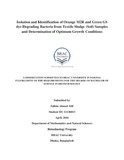| dc.contributor.advisor | Siddique, Romana | |
| dc.contributor.author | Alif, Fahim Ahmed | |
| dc.date.accessioned | 2016-06-02T13:42:07Z | |
| dc.date.available | 2016-06-02T13:42:07Z | |
| dc.date.copyright | 2016 | |
| dc.date.issued | 2016-04 | |
| dc.identifier.other | ID 11136013 | |
| dc.identifier.uri | http://hdl.handle.net/10361/5432 | |
| dc.description | This thesis report is submitted in partial fulfillment of the requirement for the degree of Bachelor of Science in Biotechnology, 2016 | en_US |
| dc.description | Cataloged from PDF version of thesis report. | |
| dc.description | Includes bibliographical references (page xvii-xx). | |
| dc.description.abstract | Environmental pollution has been confessed as one of the major troublesome of the 21st century. Most severely damaged part of this planet is its precious unique water bodies and in this deterioration textile and dyeing industries playing a major role as releasing intensely complex effluent containing highly toxic and long persistent Azoic dyes with extreme physiochemical condition. The existing physical and chemical effluent treatment methods are not cost effective. As those treatments generate huge amount of sludge and to dispose the sludge is a major problem. On the contrary Biological treatment using acclimatized microorganisms could remove 99-100% dye colour from wastewater. Hence nowadays most of the research is concentrated on biotransformation of textile azo dyes by adapted organisms. Modern bio-treatment offers a cheaper and environmentally friendly alternative for color removal of textile effluents which is very fascinating. So this research is to find out some highly effective Azo dye degrading bacterial isolates from effluent disposal areas soil.
The bacterial inoculums were isolated from effluent soil samples and then applied for azo dye decolourization into flasks containing azo dyes as a sole carbon source (1g/L) with trace amounts of yeast extract, glucose, peptone and some others essential salts and incubated for 5 days to observe their decolourizing ability. The decolourization was inferred from the decrease in the optical density of the dye effluent.
The bacterial strains identefied in the study were Entorococcus termitis, Entorococcus camelliae, Bacillus farraginis, Bacillus muralis, Paenibacillus macerans, Bacillus decolorationis, and Macrococcus brunensis. Out of these isolates Entorococcus termitis, Bacillus farraginis, Paenibacillus macerans, Bacillus decolorationis emerged out to be most potent decolourizer, being selected for further studies. Bacillus farraginis was identified as the best decolourizer of OM2R (Orange M2R) dye that decolourized 98% of the dye and Paenibacillus macerans showed maximum decolourization on GGS(Green GS) dye that decolourized 97% of the dye. The effect of pH, NaCl, temperature and initial concentration of dye was studied with an aim to determine the optimal conditions required for maximum decolourization. The research showed different decolourization rate with varying parameters. The optimum pH for decolourization of OM2R and GGS dye was 7.0, the optimum NaCl concentration for decolourization was 2%, initial dye concentration was 1% and the temperature was 370C for optimum decolourization by the selected isolates. The findings are well acclimatized and have potentials for bioremediation in textile waste effluent treatment plants. | en_US |
| dc.description.statementofresponsibility | Fahim Ahmed Alif | |
| dc.format.extent | 58 pages | |
| dc.language.iso | en | en_US |
| dc.publisher | BRAC University | en_US |
| dc.rights | BRAC University thesis are protected by copyright. They may be viewed from this source for any purpose, but reproduction or distribution in any format is prohibited without written permission. | |
| dc.subject | Biotechnology | en_US |
| dc.title | Isolation and identification of orange M2R and green GS dye degrading bacteria from textile sludge (soil) samples and determination of optimum growth conditions | en_US |
| dc.type | Thesis | en_US |
| dc.contributor.department | Department of Mathematical and Natural Science, BRAC University | |
| dc.description.degree | B. Biotechnology | |

